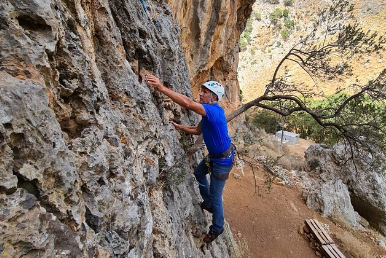Crete, the largest of the Greek islands, is renowned for its diverse landscapes, ranging from sandy beaches and fertile plains to rugged mountains and deep gorges. This rich topography makes it a paradise for outdoor enthusiasts, particularly those passionate about mountain climbing and trekking. The island’s mountainous regions offer a unique blend of natural beauty, historical significance, and challenging terrain, making Cretan mountain climbing and trekking adventures an unforgettable experience.
The Allure of Crete’s Mountains
Crete’s mountainous terrain is dominated by three major ranges: the White Mountains (Lefka Ori) in the west, the Idi Range (Psiloritis) in the central part of the island, and the Dikti Range in the east. Each of these ranges offers a distinct set of challenges and rewards for climbers and trekkers, from high peaks and deep gorges to ancient paths and stunning vistas.
Psiloritis: The Roof of Crete
Psiloritis, also known as Mount Ida, is the highest peak on Crete, standing at 2,456 meters. Climbing Psiloritis is a must for serious trekkers and mountaineers. The ascent typically begins from the Nida Plateau, a high-altitude plain known for its scenic beauty and the legendary Ideon Cave, where, according to Greek mythology, Zeus was born.
The climb to the summit of Psiloritis is challenging but immensely rewarding. The trail winds through rocky terrain, sparse vegetation, and offers breathtaking views of the surrounding landscape. On a clear day, the summit provides a panoramic view of the entire island, and climbers can often see both the Cretan and Libyan seas. The sense of accomplishment and the connection to ancient myth make this climb a truly extraordinary adventure.
The White Mountains: A Trekker’s Paradise
The White Mountains, or Lefka Ori, are located in western Crete and are famous for their dramatic scenery and challenging trails. This range includes over 50 peaks that exceed 2,000 meters, the highest being Pachnes at 2,453 meters. The White Mountains are also home to the famous Samaria Gorge, one of the longest gorges in Europe and a highlight of any trekking adventure in Crete.
Trekking through the Samaria Gorge is a popular activity that attracts thousands of visitors each year. The 16-kilometer trail descends from the Omalos Plateau to the coastal village of Agia Roumeli, offering trekkers the chance to experience stunning rock formations, lush vegetation, and a diverse array of wildlife. The gorge is part of the Samaria National Park, which is a protected area known for its ecological significance.
For those seeking more remote and less crowded trails, the White Mountains offer numerous other trekking routes, such as the E4 European long-distance path. This path crosses the island from east to west, providing trekkers with a comprehensive experience of Crete’s varied landscapes and cultural heritage.
The Dikti Range: A Journey Through History
The Dikti Range in eastern Crete is another fantastic destination for mountain climbing and trekking. This range is known for its picturesque landscapes, traditional villages, and the famous Dikteon Cave, where, according to mythology, Zeus was hidden by his mother Rhea to escape his father Cronus.
One of the most popular treks in the Dikti Range is the ascent of Mount Dikti, which stands at 2,148 meters. The climb offers stunning views of the Lassithi Plateau, a fertile plain dotted with traditional windmills and ancient archaeological sites. The trail to the summit is relatively moderate, making it accessible to a wider range of trekkers, and the panoramic views from the top are truly spectacular.
Trekking Adventures and Cultural Exploration
One of the unique aspects of trekking and climbing in Crete is the opportunity to combine outdoor adventure with cultural exploration. The island is rich in history and mythology, and many trails pass by ancient ruins, Byzantine chapels, and traditional villages where time seems to stand still. Interacting with the local Cretan people, known for their hospitality and warmth, adds a cultural dimension to the trekking experience.
For example, the E4 European long-distance path not only offers challenging terrain and breathtaking scenery but also takes trekkers through some of Crete’s most historic and culturally significant sites. From the ancient city of Lato to the beautiful town of Chania, this trail provides a deep dive into the island’s rich heritage.
Practical Tips for Adventurers
For those planning a mountain climbing or trekking adventure in Crete, it’s important to come prepared. The island’s terrain can be rugged and challenging, so proper footwear, sufficient water, and appropriate gear are essential. Hiring a local guide can enhance the experience, providing valuable insights into the area’s history, flora, and fauna, as well as ensuring safety on the trails.
Spring and autumn are the best seasons for trekking in Crete, as the weather is mild and the landscapes are lush and vibrant. Summer can be extremely hot, especially in lower altitudes, while winter can bring snow and cold temperatures to the higher peaks.
Conclusion
Cretan mountain climbing and trekking adventures offer an extraordinary blend of natural beauty, physical challenge, and cultural exploration. Whether scaling the heights of Psiloritis, trekking through the dramatic Samaria Gorge, or exploring the historical trails of the Dikti Range, adventurers are sure to be captivated by the island’s rugged charm and timeless allure. Crete, with its diverse landscapes and rich heritage, truly stands out as a premier destination for those seeking outdoor adventure and a deeper connection with nature and history.


